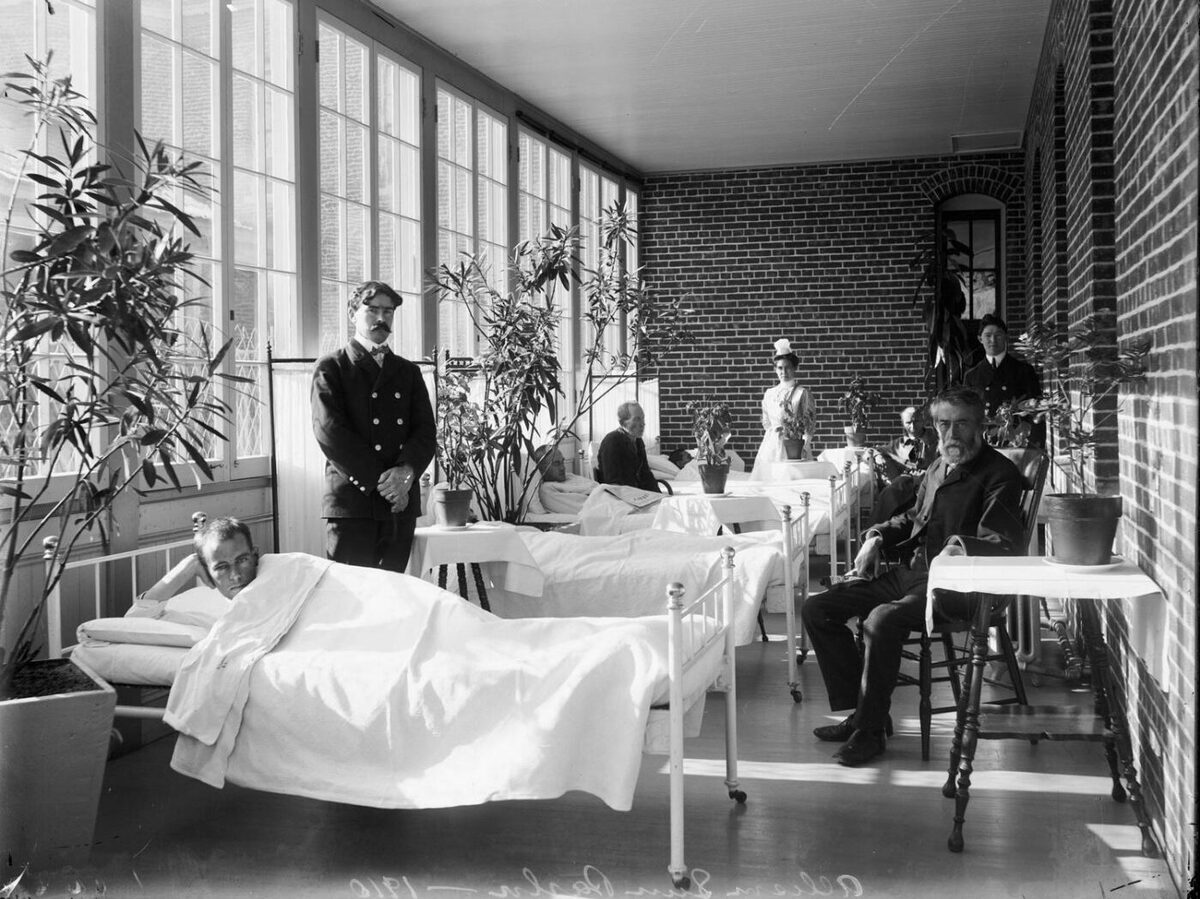Nationwide Archives and Information Administration/Nationwide Constructing Museum

Nationwide Archives and Information Administration/Nationwide Constructing Museum
Probably the most tough and costly questions {that a} society faces is the best way to care for individuals who can’t look after themselves, and the best way to pay for it. Over the past century, the USA has radically modified the way it solutions this query relating to treating folks with extreme psychological sicknesses. Now we look like getting ready to one other main change.
Within the mid-to-late twentieth century, America closed a lot of the nation’s psychological hospitals. The coverage has come to be generally known as deinstitutionalization. At the moment, it is more and more blamed for the tragedy that 1000’s of mentally sick folks sleep on our metropolis streets. Wherever it’s possible you’ll stand in that debate, the reform started with good intentions and arguably may have gone a lot in a different way with extra funding.
In October 1963, simply weeks earlier than he was assassinated, President John F. Kennedy signed into regulation landmark laws that aimed to rework psychological healthcare in the USA.
For many years, the USA had locked away folks deemed to be mentally sick in asylums. At their top, in 1955, these state-run psychiatric hospitals institutionalized a staggering 558,922 People.
Investigative journalists, authorities officers, and heartbreaking books like 1962’s One Flew Over The Cuckoo’s Nest uncovered People to the horrors of the asylum system and sparked a motion for reform. In the meantime, new prescribed drugs like chlorpromazine (also called Thorazine) burst onto the scene, holding the promise to deal with folks with psychological afflictions with out the necessity for around-the-clock supervision. The asylum system was an enormous price to taxpayers, which helped reformers unite with fiscal conservatives to construct a coalition for change.
For President Kennedy, the motion to reform psychological healthcare was private. His youthful sister, Rosemary Kennedy, had been born with mental disabilities — and her therapy is illustrative of a few of the horrors of the asylum period. Kennedy’s mother and father had spent years sending Rosemary to particular clinics and permitting medical doctors to topic her to experiments, like injecting her filled with hormones as an adolescent. In 1941, surgeons satisfied the Kennedy patriarch, Joseph Kennedy, of the necessity for a newfangled medical process: a lobotomy. The process concerned slicing out a part of Rosemary’s mind.
Rosemary’s surgical procedure went terribly flawed (even for a lobotomy, which is now a medically suspect and intensely uncommon process). The surgeons eliminated an excessive amount of of her frontal lobe. Straight away Rosemary grew to become fully disabled, dropping the power to speak, stroll, and management her bodily capabilities. Fearing embarrassment for his formidable household, Joe Kennedy had his daughter institutionalized — and he stored his household and the general public at the hours of darkness about what had actually occurred to her. It wasn’t till 1958 when then-Senator John Kennedy tracked down his sister and secretly paid her a go to. He was shocked by what he discovered.
Like his sister, Eunice Kennedy Shriver, who would go on to discovered the Particular Olympics, President Kennedy was impressed by his sister to combat for a greater future for folks with psychological disabilities. And so, in 1963, he signed into regulation the Group Psychological Well being Act. The invoice offered funding for analysis into psychological disabilities and, extra importantly, sought to dismantle the sprawling asylum system. It was the final invoice Kennedy would signal into regulation.
“Beneath this laws, custodial psychological establishments will likely be changed by therapeutic facilities,” President Kennedy stated when he signed the invoice into regulation. “It needs to be attainable, inside a decade of two, to cut back the variety of sufferers in psychological establishments by 50% or extra.” In reality, on account of this regulation and different coverage adjustments, by the 2000s, the variety of folks in asylums would find yourself plummeting over 90%.
In the meantime, supporters of civil rights for mentally sick people received a string of victories in state legislatures and the courts that made it more durable to detain and medicate folks in opposition to their will.
Somewhat than locking them away in state-run psychiatric hospitals, Kennedy and different reformers hoped to present folks with psychological sicknesses the liberty to dwell of their communities and obtain care from native organizations. Nevertheless, the Group Psychological Well being Act failed to supply sufficient funding for the 1,500 group well being facilities that lawmakers had initially envisioned. Congress left a lot of the funding to the states, and, in the end, solely about half of the well being facilities ended up being constructed and those who did find yourself getting created had been largely underfunded.
Each within the Sixties as governor of California and within the Nineteen Eighties as president, Ronald Reagan was an vital determine in slicing funding to group well being facilities. However this was just one a part of a broader — and bipartisan — set of actions and inactions which have led to collective neglect for this weak inhabitants. One cause could also be that folks with psychological disabilities aren’t precisely a strong voting bloc.
At the moment, lots of those that would traditionally be institutionalized in asylums at the moment are as an alternative incarcerated in jail, biking out and in of emergency rooms, and dwelling on the streets. Nowhere is that this extra clear than the town of Los Angeles, which has a swelling inhabitants of homeless folks, lots of whom undergo from psychological sickness.
In a brand new ebook titled Sons, Daughters, and Sidewalk Psychotics, UC San Diego sociologist Neil Gong grapples with the system of psychological healthcare that Los Angeles has adopted within the wake of the closure of asylums.
“With hindsight, the triumph of deinstitutionalization seems to be extra like a tragic irony: an unlikely coalition of civil libertarian liberals and financial conservatives pushed for the destruction of an abusive and neglectful system that had nonetheless housed, fed, and arranged the lives of over half 1,000,000 folks,” Gong writes.
A Disaster Inside A Disaster
As we have lined earlier than on this e-newsletter, analysis means that the homelessness disaster in states like California is primarily a narrative about housing provide and demand. There’s not sufficient housing for people who want it. The general public going through homelessness aren’t mentally sick.
Nevertheless, psychological sickness is a big predictor of who turns into homeless — and particularly of who stays homeless for a very long time. Analysis estimates that over 20% of People experiencing homelessness — and a bigger proportion of these experiencing long-term homelessness — undergo from extreme psychological sicknesses.
Gong calls the strategy that cities like Los Angeles have taken to this drawback “tolerant containment.” Principally, the town tolerates issues like encampments, weird conduct in public, and drug use so long as it is contained in segregated areas which might be largely out of sight of nearly all of metropolis residents.
Whether or not you are a progressive or conservative, particularly in California, it is fairly universally accepted that this established order shouldn’t be working. It is each inhumane and in addition surprisingly costly. Letting this at-risk inhabitants languish on the streets imposes an entire bunch of downstream taxpayer prices like repeat emergency room visits, police work, disaster care, and incarceration — none of which measurably enhance the long-term outcomes for this inhabitants. The query is: what ought to we do now?
Many progressives have advocated for a “housing first” answer to the issue of homelessness. Principally, they argue, as an alternative of specializing in getting this at-risk inhabitants psychiatric assist or rehab, the precedence needs to be getting them into steady housing first after which specializing in offering different providers. Nevertheless, Gong suggests, in Los Angeles and different cities, too usually the main target has turn into what you would possibly name housing solely. “As a result of these public or nonprofit suppliers are under-resourced and understaffed, it type of ends there,” Gong says. This coverage typically might be efficient, he says, however typically it means “abandoning folks to self-destruct.”
A randomized managed trial carried out in Santa Clara, California, discovered that offering chronically homeless people with everlasting housing and voluntary supportive providers had an 86% success fee by way of protecting them from returning to dwelling on the streets. This and comparable findings by different research have been hailed by advocates as a slam-dunk validation for the housing first strategy to tackling homelessness. However, Gong says, it additionally suggests there’s nonetheless a large inhabitants — the remaining 14 p.c — that want extra than simply housing and entry to what’s at present accessible to them for providers. In a state like California, which has an enormous inhabitants of chronically unhoused folks, an 86% success fee suggests there would nonetheless be 1000’s of individuals dwelling on the streets.
“I do imagine that if we’re capable of ship the type of community-based providers that had been promised 60 years in the past, we may whittle that quantity down,” Gong says.
Nevertheless, Gong acknowledges that, even with everlasting housing and higher high quality social and psychiatric providers, there would nonetheless be some small proportion of oldsters who would nonetheless wind up dwelling on the streets. And for these people the federal government, he argues, might have to impose “extra assertive or coerced therapy, together with even, in some circumstances, longer-term in-patient care.” In different phrases, a contemporary, extra humane model of a psychological asylum or one thing comparable.
For this inhabitants who will get pressured therapy, Gong stresses, we actually should be cautious. He cites analysis that this form of obligatory care might be actually traumatizing for sufferers and even end in a better threat of suicide. “So one factor we actually want to determine the best way to do is to make the small quantity of pressured therapy that we would want higher.”
Reinstitutionalization
We’re now at a crossroads the place there is a bipartisan motion for what you would possibly name reinstitutionalization. We’re not going again to the horrors of lobotomies and compelled sterilizations of the asylum period, however a rising variety of Democrats and Republicans declare that it is now essential to make use of better drive to require therapy for mentally sick people within the quest to finish homelessness.
New York Metropolis mayor Eric Adams has for the final couple years pursued a pilot program that provides the police and medical staff the ability to involuntarily hospitalize the mentally sick.
Late final yr, former president Donald Trump posted a video on his marketing campaign web site, remarking, “When I’m again within the White Home, we are going to use each software, lever, and authority to get the homeless off our streets.” He continued: “And for individuals who are severely mentally sick and deeply disturbed, we are going to convey them again to psychological establishments, the place they belong… with the aim of reintegrating them again into society as soon as they’re effectively sufficient to handle.”
Not too long ago, California voters narrowly handed Proposition 1, which was championed by Governor Gavin Newsom. Teams just like the ACLU opposed this poll measure on the grounds that it could strip funds from group well being organizations and “primarily fund pressured therapy and institutionalization.”
Neil Gong admits he is fearful that the pendulum is swinging again to a extra draconian and fewer humane strategy to how we deal with the mentally sick. “I undoubtedly fear that we will transfer to this type of heavy-handed, lock-people-up, get-them-outta-sight-in-the-cheapest-way-possible strategy,” Gong says. However, he says, with a lot obvious political will to do one thing about the issue, he maintains hope we will construct a greater future for a few of the most weak folks in our society.




